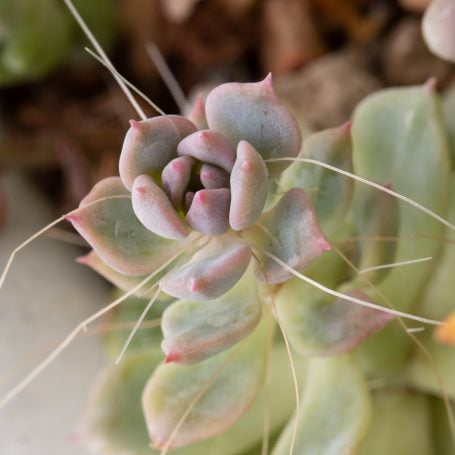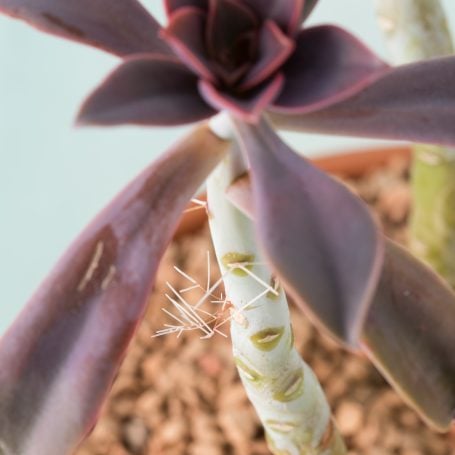If you’ve had your succulent for a while, you may have noticed some aerial roots or air roots appearing on the stem. This isn’t a serious issue, but it is an indication that your succulent needs some care. Here’s what you need to do to help it.
I take it you have noticed some roots coming out of the stem of your succulent plant?
The great news is that your succulent will survive with a bit of extra care.
When you buy something through the links on this website, we may get a commission that won’t cost you extra. This helps us give you free content without charging you.
People often wonder if the presence of aerial roots on their succulent is an indication that they need to water it. I’ll explain that in more detail in this post.
To give you additional guidance, get my complimentary cheat sheet to get an idea of when to water your succulents more or less. Click this link to get it, it will be really useful.
Aerial roots are roots that sprout from the stem of your succulent, instead of growing in the soil. These roots usually appear in shades of pink or white.
Table of Contents
What causes aerial roots to grow?
In general, if a succulent is not receiving enough water or is in a humid area, aerial roots may form. These roots allow the plant to uptake moisture from the air in order to stay hydrated.
It is essential for the wellbeing of succulents to have soil with large particles.
If you aren’t adequately watering your succulent, it may not be getting enough moisture and will begin to produce aerial roots as it searches for more.
Your succulent is indicating that it needs more water and a thorough soaking.
Observe the desiccated condition of the base of the Crassula rupestris plant and the presence of numerous aerial roots.
This plant has become very elongated due to insufficient sunlight, which can cause it to send out aerial roots.
In many instances, when a succulent is beginning to grow upwards, it will tend to emit aerial roots.
Do all succulents grow aerial roots?
In other words, if you are providing adequate moisture, you should not encounter any aerial roots.
Succulents that grow quickly and are in their active growing season may be more prone to “air roots,” such as with Graptoveria ‘Fred Ives’ and its Graptopetalum hybrid. These plants are especially likely to stretch out in search of more light if not provided with enough.
- ‘Fred Ives’ is a hybrid succulent plant.
What should I do about the air roots?
It’s not necessary to take out the roots, but if they’re becoming bothersome, you can. Make sure to give your succulent more thorough watering instead of more often, and don’t forget to provide it with enough light.
If the roots remain intact, they may become thicker and appear to look like a small branch. This is a natural process.
It is important to be mindful of aerial roots when caring for your succulent, as they are an indication of an unhealthy plant. Be sure to adjust your care routine accordingly to ensure your succulent stays in good condition.
Don’t forget to grab my handy cheat sheet to help you understand when your succulents need more or less water. Click the link to get your copy.
FAQ
Will aerial roots turn into normal roots?
Can succulents survive with exposed roots?
It is not advised to leave seedling succulents with their roots exposed. For mature succulents, however, they can be left with their roots exposed for up to a week before replanting, in order to allow them to dry out.
Why is my succulent growing aerial roots?
Generally, succulents that are not getting enough water or are placed in a humid environment will form aerial roots. These roots absorb moisture from the air, which is why it is essential to use a soil with large particles for optimal succulent health.
Are aerial roots bad for succulents?
The presence of aerial roots on succulents is beneficial to those with waterlogged soil, as their small pores help the plants intake air. Additionally, they are useful in aiding propagation- if a trailing plant like a burro’s tail or string of pearls were cut off, aerial roots allow the new cuttings to quickly absorb the necessary water and nutrients.


